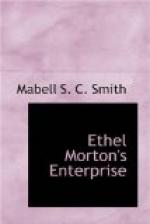As the boat continued up the river it passed many such tipples. They were now in the soft coal country, the steersman said, and in due time they arrived at Millsboro, a little town about ten miles above Brownsville.
Here Mr. Emerson made immediate inquiries about Stanley Clark, and found that he had gone on, leaving “Uniontown, Fayette County,” as his forwarding address. “That’s the county seat where Hapgood says he copied his records,” said Mr. Emerson. “I hope we shall catch young Clark there and get that matter straightened out.”
As there was no train to Uniontown until the afternoon, Mr. Emerson engaged a motor car to take them to a large mine whose tipple they had passed on the way up. The Superintendent was a friend of the driver of the car and he willingly agreed to show them through. Before entering the mine he pointed out to them samples of coal which he had collected. Some had fern leaves plainly visible upon their surfaces and others showed leaves of trees and shrubs.
“Fairy pencilings, a
quaint design,
Veinings, leafage, fibers
clear and fine,”
quoted Ethel Blue softly, as she looked at them.
Mrs. Morton stopped before a huge block of coal weighing several tons and said to her son, “Here’s a lump for your furnace, Roger.”
“Phew,” said Roger. “Think of a furnace large enough to fit that lump! Do you get many of them?” he asked of the Superintendent.
“We keep that,” said the Superintendent, “because it’s the largest single lump of coal ever brought out of this mine. Of course, we could get them if we tried to, but it’s easier to handle it in smaller pieces.”
“What’th in that little houthe over there?” asked Dicky. “Theems to me I thee something whithing round.”
“That’s the fan that blows fresh air into the mine so that the miners can breathe, and drives out the poisonous and dangerous gases.”
“What would happen if the fan stopped running?” asked Ethel Brown.
“Many things might happen,” said the Superintendent gravely. “Men might suffocate for lack of air, or an explosion might follow from the collection of the dreaded ‘fire damp’ ignited by some miner’s lamp.”
“Fire damp?” repeated Mrs. Morton. “That is really natural gas, isn’t it?”
“Yes, they’re both ‘marsh gas’ caused by the decay of the huge ferns and plants of the carboniferous age. Some of them hardened into coal and others rotted when they were buried, and the gas was caught in huge pockets. It is gas from these great pockets that people use for heating and cooking all about here and even up into Canada.”
Ethel Brown had been listening and the words “some of them hardened into coal” caught her ear. She went close to her grandfather’s side.
“Tell me,” she said, “exactly what is coal and how did it get here?”
“What I want to know,” retorted Mr. Emerson, “is what brand of curiosity you have in your cranium, and how did it get there? Answer me that.”




